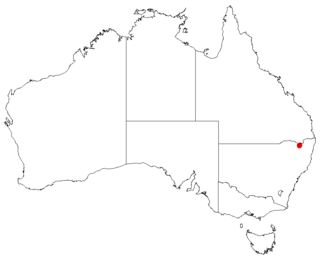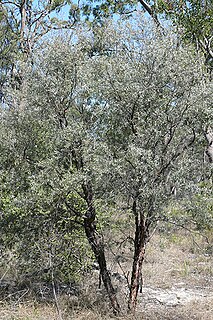
Homoranthus is a genus of about thirty species of plants in the myrtle family Myrtaceae and all are endemic to Australia. Plants in this genus share similarities with those in both Darwinia and Verticordia. They are shrubs with their leaves arranged in opposite pairs and with flowers appearing either singly or in small groups, usually in upper leaf axils. They are found in Queensland, New South Wales and South Australia. The genus was first described in 1836. None of the species is common nor are they well-known in horticulture.
Eucalyptus provecta is a species of small tree that is endemic to Queensland. It has rough, fibrous to flaky bark on the trunk and branches, lance-shaped adult leaves, flower buds in groups of seven on the ends of branchlets, white flowers and cup-shaped fruit.

Eucalyptus rhombica is a small to medium-sized tree that is endemic to a small area of south-east Queensland. It has rough, ironbark on the trunk and larger branches, smooth bark above, lance-shaped adult leaves, flower buds in groups of seven, white flowers and cup-shaped or conical fruit.
Eucalyptus tholiformis is a species of tree that is endemic to a small area in Queensland. It has rough, deeply furrowed iron bark on the trunk and larger branches, lance-shaped adult leaves, flower buds in groups of seven, white flowers and cup-shaped to funnel-shaped fruit.

Kunzea obovata is a flowering plant in the myrtle family, Myrtaceae and is endemic to eastern Australia. It is a spreading shrub with unusually-shaped leaves and clusters of pink to purple flowers. It is restricted to northern New South Wales and south-eastern Queensland.
Kunzea calida is a plant in the myrtle family, Myrtaceae and is endemic to Queensland, Australia. It is a spreading shrub which has linear to lance-shaped leaves but which are rolled, making them appear cylindrical. The flowers are pinkish-purple and arranged in groups near the ends of the branches in September. It is only known in remote and rugged areas of the Mount Stewart Ranges near Homestead.

Homoranthus binghiensis is a flowering plant in the family Myrtaceae and is endemic to a small area in northern New South Wales. It is an upright shrub with pointed leaves and usually paired yellowish to red flowers.

Homoranthus decasetus is a plant in the myrtle family Myrtaceae and is endemic to a small area in central Queensland. It has small, thin leaves and flowers that fade to purple as they age.

Homoranthus decumbens is a plant in the myrtle family Myrtaceae and is endemic to a small area in Queensland. It is a low, spreading shrub with cylindrical leaves arranged in alternating opposite pairs. The flowers are yellowish green and arranged singly in upper leaf axils.
Homoranthus tricolor, is a plant in the myrtle family Myrtaceae and is endemic to a small area in south-east Queensland. It is an upright shrub with linear to lance-shaped leaves and green, red and black flowers arranged singly or in pairs in upper leaf axils. It is only known from a single population near Mundubbera.
Eucalyptus erosa is a species of tree that is endemic to a small area of Queensland. It has rough, fibrous to stringy grey bark, lance-shaped to curved adult leaves, flower buds arranged in groups of between nine and thirteen, white flowers and cup-shaped to hemispherical fruit.

Leptospermum barneyense is a species of shrub that is endemic to the Mount Barney National Park in Queensland. It has rough, fibrous bark, young branches with conspicuous flanges, lance-shaped leaves, white or pink flowers and hemispherical fruit.

Leptospermum lamellatum is a species of shrub or small tree that is endemic to inland Queensland and has distinctive reddish, layered bark. It has narrow elliptical leaves, white flowers and small fruit that fall from the plant when mature.
Leptospermum pallidum is a species of spreading shrub that is endemic to Queensland. It has thin, firm, rough bark, narrow lance-shaped leaves, white flowers arranged in groups of two or three on side shoots and fruit that remains on the plant until it dies.
Triplarina bancroftii is a species of flowering plant in the myrtle family, Myrtaceae and is endemic to a restricted area of Queensland. It is a shrub with egg-shaped or elliptic leaves, flowers with five sepals and five relatively small white petals and sixteen to eighteen stamens.
Triplarina calophylla is a species of flowering plant in the myrtle family, Myrtaceae and is endemic to a restricted area of north Queensland. It is a shrub with egg-shaped leaves with the narrower end towards the base, flowers with five sepals, five white petals and fourteen or fifteen stamens.
Triplarina nitchaga is a species of flowering plant in the myrtle family, Myrtaceae and is endemic to a restricted area of north Queensland. It is a shrub with lance-shaped leaves with the narrower end towards the base, flowers with five sepals, five white petals and seventeen or eighteen stamens.
Triplarina nowraensis, commonly known as Nowra myrtle heath, is a species of flowering plant in the myrtle family, Myrtaceae and is endemic to a restricted area of New South Wales. It is a shrub with egg-shaped to lance-shaped leaves with the narrower end towards the base, flowers with five sepals, five cream-coloured to white petals and fifteen to seventeen stamens.
Triplarina paludosa is a species of flowering plant in the myrtle family, Myrtaceae and is endemic to the Blackdown Tableland in Queensland. It is a shrub with lance-shaped to linear leaves, flowers with five sepals, five white petals and fifteen to eighteen stamens.

Triplarina volcanica is a species of flowering plant in the myrtle family, Myrtaceae and is endemic to Queensland, where it is only found in three mountainous areas. It is a shrub with elliptical to egg-shaped leaves with the narrower end towards the base and flowers with five sepals, five white petals and fourteen to sixteen stamens.









